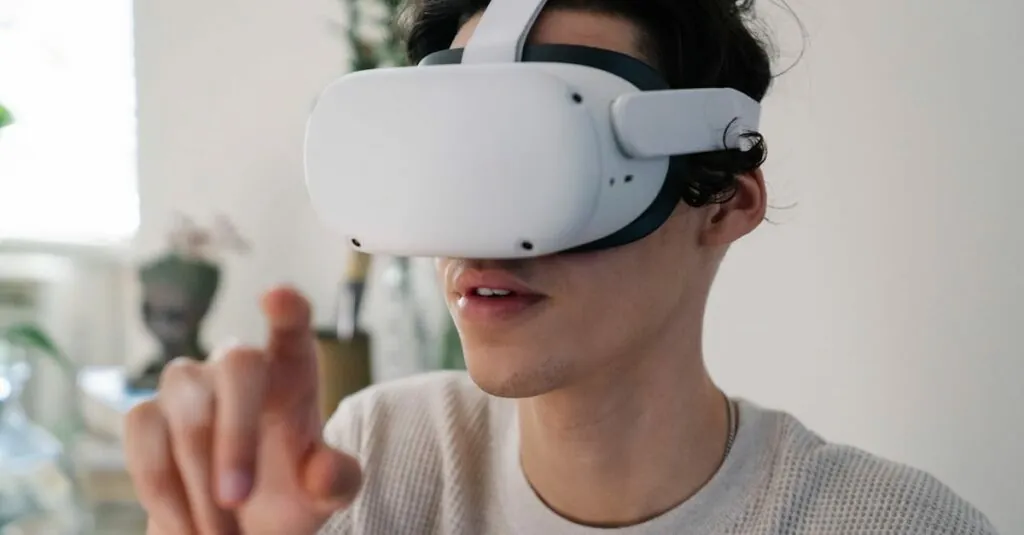Table of Contents
ToggleImagine walking through your living room and suddenly seeing a dinosaur lounging on your couch. Sounds wild, right? That’s the magic of web-based augmented reality. It’s not just for sci-fi movies anymore; it’s a game changer in how we interact with the digital world. With just a smartphone or tablet, anyone can blend the real and virtual worlds in ways that make even the most skeptical techie raise an eyebrow.
Overview of Web Based Augmented Reality
Web-based augmented reality (AR) merges digital content with the physical world, enhancing user experiences. This technology utilizes web browsers to provide access to AR without requiring heavy applications.
Definition and Scope
Web-based augmented reality refers to applications that deliver AR content directly through web browsers. Users access this technology without needing to install specific apps, enabling effortless interaction with 3D objects, animations, and information overlays. AR extends across various industries, including retail, education, and tourism, enhancing user engagement and understanding by providing interactive and immersive experiences.
Key Technologies Involved
Several technologies drive web-based augmented reality. WebGL serves as a crucial component, enabling 3D rendering in web browsers. Alongside WebGL, JavaScript frameworks like A-Frame and Three.js facilitate the creation of interactive AR content. Additionally, cloud computing supports the storage and processing of large datasets, ensuring quick access to AR experiences. Computer vision also plays a vital role, allowing devices to recognize and track physical objects, ultimately enhancing the AR experience for users.
Benefits of Web Based Augmented Reality
Web-based augmented reality offers numerous advantages, transforming user experiences across various sectors. Enhanced interaction and accessibility characterize this technology.
Enhanced User Engagement
User engagement improves significantly through web-based AR. Immersive experiences captivate users, making learning and shopping more interactive. For instance, customers can visualize products in their environments before purchasing, increasing satisfaction. Educational tools leverage this technology to create dynamic learning scenarios, sparking curiosity and boosting retention. Users often describe these immersive interactions as more memorable than traditional methods. Stakeholders observe enhanced brand loyalty due to the memorable experiences that web-based AR can provide.
Cost-Effectiveness
Cost-effectiveness stands out as another key benefit of web-based AR. Businesses avoid expensive app development by utilizing web technologies, reducing overall expenses. Implementation remains straightforward, with minimal ongoing maintenance required. Companies leverage cloud computing to deliver content without investing heavily in hardware. Users only need a compatible browser to access interactive elements, eliminating barriers associated with app installations. As a result, organizations witness quicker deployment and broader audience reach, enhancing their return on investment.
Applications of Web Based Augmented Reality
Web-based augmented reality finds diverse applications across various industries, significantly enhancing interactive experiences.
Retail and E-Commerce
Retailers leverage web-based AR to allow customers to visualize products in their own spaces. Using a smartphone camera, shoppers can preview how furniture fits in their living rooms or see how clothing looks on their digital avatars. This approach not only boosts customer confidence but also reduces product returns. Many brands report increased engagement through AR experiences, leading to higher conversion rates. A recent survey indicated that 61% of consumers prefer stores that offer AR solutions. By integrating AR into their websites, retailers create a shopping journey that’s innovative and user-friendly.
Education and Training
In education, web-based AR revolutionizes how students learn and engage with content. Interactive models allow students to explore complex concepts in a tangible way. For instance, biology students can examine a 3D heart model to understand its anatomy visually. Teachers utilize AR in lesson plans, enhancing retention and understanding. Reports show that students retain 80% of what they see and do. Training programs in various industries benefit from AR too, facilitating realistic simulations that prepare employees for real-world tasks. This immersive learning environment fosters engagement and skill mastery.
Real Estate and Property Management
Web-based AR transforms the real estate market by enabling virtual property tours. Prospective buyers can explore listings remotely, visualizing spaces without needing to visit in person. Many agencies incorporate AR features on their websites, allowing users to navigate properties at their convenience. Interactive elements, such as furniture placement and renovation previews, enrich the viewing experience. Statistics reveal that listings with AR features attract 40% more clicks than standard ones. Through enhanced visualizations, tenants and buyers can make informed decisions, improving overall satisfaction and reducing time on the market.
Challenges and Limitations
Web-based augmented reality faces several challenges and limitations that affect its widespread adoption and functionality.
Technical Constraints
Users encounter various technical constraints with web-based AR. Internet connectivity impacts the performance of AR experiences, as slow connections can lead to lag and reduced interactivity. Device compatibility presents another challenge, with different operating systems resulting in inconsistent experiences across smartphones and tablets. Additionally, AR relies on data processing capabilities; limited processing power hinders the rendering of high-quality graphics and animations. Integration with existing systems remains complex, complicating the development of seamless user experiences.
User Privacy Concerns
User privacy concerns pose significant hurdles for web-based AR. Collecting user data often raises questions about how information is stored and utilized. Many users express discomfort regarding location tracking, fearing that their movements and preferences are monitored. Transparency in data handling becomes crucial to build user trust. Security breaches can lead to sensitive information exposure, making users apprehensive about engaging with AR applications. Addressing these privacy concerns is essential for gaining user acceptance and fostering a secure environment in which AR can flourish.
Future Trends in Web Based Augmented Reality
Web-based augmented reality continues to evolve, driven by innovation and market demand. Anticipating trends offers insights into how this technology might reshape user experiences.
Emerging Technologies
Integration of cutting-edge technologies enhances web-based AR capabilities. Artificial intelligence algorithms improve object recognition accuracy and streamline user interactions. 5G connectivity expands the potential for real-time data processing, enabling richer experiences without latency issues. Progressive Web Apps (PWAs) eliminate reliance on traditional app stores, offering seamless access to AR experiences via browsers. Affordable AR glasses gain traction, providing hands-free interaction while navigating virtual environments. Blockchain technology fosters transparency in data management, addressing privacy concerns more effectively. Together, these advancements pave the way for more immersive, engaging AR experiences.
Potential Market Growth
The market for web-based AR is poised for substantial growth. Analysts predict it could reach $50 billion by 2025, driven by increased adoption across various sectors. Retailers leverage AR for virtual try-ons and product visualizations, resulting in higher conversion rates. The education sector embraces these tools, enhancing remote learning and interactive curriculum development. Interest from tourism and real estate firms opens new avenues for virtual experiences, such as guided tours and property showcases. As businesses increasingly invest in AR technology, return on investment expands alongside user engagement, creating a cycle of growth that strengthens the market further.
Web-based augmented reality is reshaping how individuals interact with digital content and their surroundings. Its accessibility and ability to enhance user experiences make it a game-changer across various industries. As technology advances and the market expands, businesses that embrace web-based AR will likely see increased engagement and customer satisfaction.
While challenges remain, the potential for innovation and growth in this field is immense. By addressing technical limitations and user privacy concerns, companies can foster a secure environment that encourages widespread adoption. With emerging technologies on the horizon, web-based AR is poised to create even more immersive and interactive experiences in the near future.




